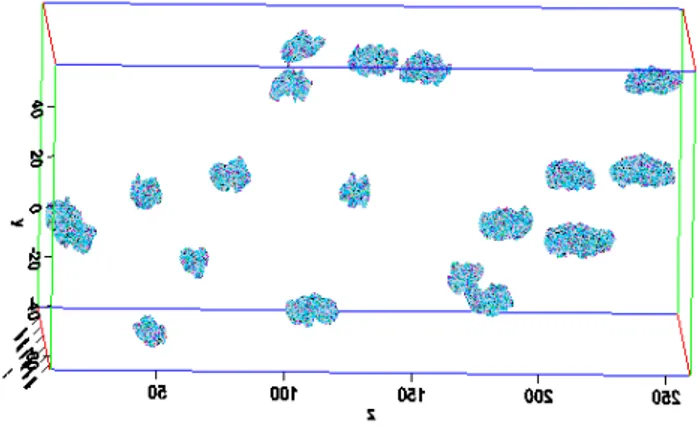HAL Id: hal-01060045
https://hal.archives-ouvertes.fr/hal-01060045
Submitted on 2 Sep 2014HAL is a multi-disciplinary open access
archive for the deposit and dissemination of sci-entific research documents, whether they are pub-lished or not. The documents may come from teaching and research institutions in France or abroad, or from public or private research centers.
L’archive ouverte pluridisciplinaire HAL, est destinée au dépôt et à la diffusion de documents scientifiques de niveau recherche, publiés ou non, émanant des établissements d’enseignement et de recherche français ou étrangers, des laboratoires publics ou privés.
Erbium environment in glass-ceramics investigated by
atom probe tomography
Wilfried Blanc, Hugues François Saint-Cyr, Isabelle Martin, Philippe Le
Coustumer, Chystel Hombourger, D.R. Neuville, D.J. Larson, T.J. Prosa,
Christelle Guillermier
To cite this version:
Wilfried Blanc, Hugues François Saint-Cyr, Isabelle Martin, Philippe Le Coustumer, Chystel Hom-bourger, et al.. Erbium environment in glass-ceramics investigated by atom probe tomography. In-ternational Conference on Luminescence, Jul 2014, Wroclaw, Poland. �hal-01060045�
ERBIUM ENVIRONMENT IN GLASS-CERAMICS INVESTIGATED BY ATOM PROBE TOMOGRAPHY
W. Blanc1,*,H. Francois-Saint-Cyr2, I. Martin2, P. LeCoustumer3, C. Hombourger2, D. Neuville4, D. J. Larson2, T. J. Prosa2, C.
Guillermier5
1 Université Nice Sophia Antipolis, CNRS, LPMC, UMR7336, 06100 Nice, France 2 CAMECA Instruments Inc., 5500 Nobel Drive, Suite 100, Madison, WI, 53711, USA 3 Université Bordeaux 3, Géo-ressources et Environnement, EA4592, 33607 Pessac, France
4 Institut de Physique du Globe de Paris, 1 rue Jussieu, 75005 Paris, France 5 National Resource for Imaging Mass Spectroscopy, Cambridge, MA 02139, USA
* Corresponding author: wilfried.blanc@unice.fr Highlights
• partition of Er3+ ions in phase-separated nanoparticles smaller than 10 nm demonstrated with APT
• elucidation on the Er3+ ions nearest neighbors
• discussion between Er3+ ions local environment and macroscopic luminescent properties
Abstract
Glass-ceramics (considered here as a glassy host containing crystalline or amorphous nanoparticles) are of interest for luminescent properties as they can combine the sturdiness and low cost of a matrix host with particular spectroscopic behavior that would not appear in this host [1]. Ideally, nanoparticles would fully encapsulate luminescent ions to produce engineered spectroscopic properties. This approach is particularly promising for optical fibers. Indeed, silica is the most common glass used to prepare such waveguides. However, it is necessary to overcome some of its characteristics (high phonon energy, low luminesent ions solubility, …) which may be detrimental to luminescent properties.
As silicate systems have a large phase immiscibility domain when they contain divalent metal oxides (such as Mg), one can take advantage of thermal treatments inherent to the MCVD (Modified Chemical Vapor Deposition) process to obtain nanoparticles through phase separation [2]. By modifying Mg concentration, we have observed modifications of luminescent properties of Er3+ ions [3]. However the question arises of the partition of rare-earth ions in nanoparticles.
Qualitative partition of erbium ions in nanoparticles was reported thanks to Secondary Ion Mass Spectrometry analyses [4]. However, the spatial resolution is about the particle size. To go further, we take advantages of recent developments in Atom Probe Tomography (APT) which allowed the extension of such studies to glass-ceramics [5]. Partition of erbium ions is clearly observed in nanoparticles smaller than 10 nm (Figure 1). During this presentation, we will discuss this partition and the most probable nearest neighbors and correlate these results with luminescent properties.
Figure 1. APT reconstructed volumes. Only Erbium ions are represented (in red). (Blue = isosurface ?) References
[1] M. Clara Gonçalves et al., C.R. Chimie 5 (2002) 845-854. [2] W. Blanc et al., J. Am. Ceram. Soc. 94 (2011) 2315-2318. [3] F. D'Acapito et al., J. Non-Cryst. Solids (2014) in press. [4] W. Blanc et al., Opt. Mater. Express 2 (2012) 1504-1510.
